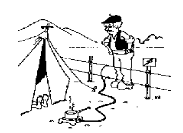OPENING CEREMONYÂ Â 
INVENTORS Make a card with the letter, tell the information.
I—IODINE-- Iodine has many uses. It is a disinfectant and a nutrient added to salt to prevent
diseases. It was discovered by accident. In 1811 Bernard Courtois was extracting sodium and
potassium compounds from seaweed ash. Once the compounds were gone, he added sulfuric acid.
A violet cloud erupted from the mass. The gas condensed on metal objects in the room.
N—NYLON-- Wallace Carothers is considered to be the father of man-made polymers. In 1928
Dupont opened a research lab to try to make a fabric that would replace silk. Japan was the source
of silk for this country and trade relations were breaking apart. World War II was about to break out.
They were able to create nylon by 1934 and nylon stockings were pretty, durable, and very desirable.
V—VACUUM CLEANER-- James Murray Spangler, a janitor in a Canton, Ohio department
store, deduced that the carpet sweeper he used was the source of his cough. He tinkered with an old
fan motor and attached it to a soapbox stapled to a broom handle. Using a pillowcase as a dust collector
on the contraption. He formed the Electric Suction Sweeper Company. William Hoover, a cousin-
in-law went into business with him and they renamed it. Sluggish sales were given a kick by Hoover’s
10 day, free home trial, and eventually there was a Hoover® vacuum cleaner in nearly every home.
E—ELASTIC-- Thomas Hancock invented the machine called a masticator, which shredded rubber
scraps. In 1820 he patented elastic fastenings for gloves, shoes, and stockings. In 1821 he joined
forces with Charles Macintosh and they produced rubber embedded raincoats. The raincoats
improved when vulcanized rubber was invented by Charles Goodyear.
N—NEON-- When electricity was discovered scientists moved towards various types of lighting.
George Claude applied an electrical discharge to a sealed tube of neon gas in 1902. He formed a
company called Claude Neon and introduced neon gas signs to the United States in 1923 when he
sold a sign to a Packard car dealership in Los Angeles. They paid $24,000 for two signs. Neon
quickly became a popular feature in outdoor advertising.

T—TELEVISION-- Philo Farnsworth was born in Beaver City, Utah. They moved to Â
Rigby, Idaho, and at 14 years old, while plowing a potato field back and forth he got the idea
that electron beams could scan images the same way. At 15, with only 2 years of High School,
he gained admission to BYU. He credited his High School teacher for helping him succeed.
O—OXYGEN TENT-- John Emerson, born in New York, disappointed his father when he did not
want to attend an Ivy League college but instead wanted to buy a machine shop and tinker with his ideas.
His mother financed the purchase and he came up with a device for tissue respiration. In 1931 he came up
with the oxygen tent. He is best known for the iron lung which during the polio epidemic in the 1930s
saved many lives.
R— RUBBER-- Explorers found the South American natives using a sticky substance that
bounced. They brought it to Europe but it had a big problem, the instant its temperature changed it
deteriorated and became rotten and smelly. Charles Goodyear became obsessed with trying
to solve the rubber dilemma. He tried everything until in 1839 he accidentally spilled rubber mixed with
sulfur on a hot stove. He was awarded the patent for Vulcanization and happily spent the rest of his life
obsessed with inventing practical uses for rubber. When he died he was $200,000 in debt.
S—STAMPS-- The first official mail office was opened in England in 1516. Nearly 300 years
later [1835] Sir Rowland Hill suggested that letters under an ounce should be carried for a uniform
fee of 1 Penny and used a stamp. Until this time the receiver paid the fee on receiving the letter.
The United States started using stamps in 1845.
Great Salt Lake Council